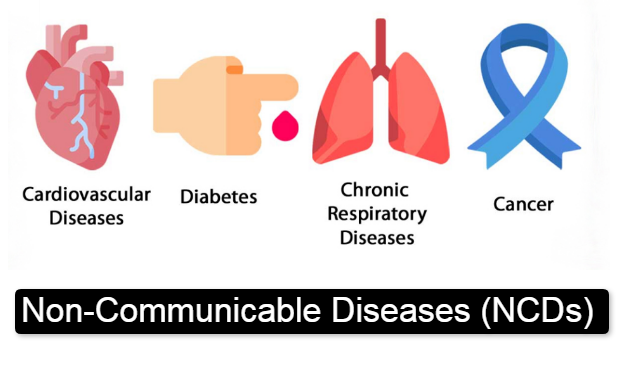
Chronic illnesses known as Non-Communicable Diseases cannot spread between individuals. Recent years have witnessed an intense increase of NCDs in India because of urban lifestyle changes, population aging, and poor health education across the population. These diseases pose significant challenges to public health systems on worldwide as well as national levels. WHO (2022) reports NCDs as the cause of 66% of all deaths throughout India during 2019.
Context:
-
The number of Non-Communicable Diseases (NCDs) is rising rapidly in urban India and women who have passed menopause experience heightened risks.
-
The major causes include modern living adaptations combined with metropolitan growth together with dietary patterns and environmental conditions.
-
The government launched initiatives which include national programs and public awareness campaigns for burden mitigation.
What are Non-Communicable Diseases?
-
Medical science defines NCDs as long-lasting chronic conditions that do not transmit through infections.
-
The most common non-communicable diseases affect the heart, lead to cancer development along with diabetes, affect respiratory function and generate mental health issues.
-
Population groups face increased risk for NCDs through unhealthy eating behavior along with physical inactivity and tobacco consumption, alcohol misuse, environmental pollutants and additional environmental contributors.
-
WHO (2022) reports NCDs as the cause of 66% of all deaths throughout India during 2019.
Role of Urbanisation in Increasing NCD Burden:
-
Shifting economic models toward service-based urban sectors lead to labor job reduction which creates more people spending inactive days.
-
The consumption of processed and fast foods leads to poor nutritional outcomes in people's dietary patterns.
-
Respiratory and cardiovascular diseases present more severe conditions due to elevated pollution levels which urban environments commonly experience.
-
People in urban areas tend to consume more alcohol and tobacco products thereby increasing their risk of NCDs.
-
City residents face higher mental health stress because the traditional joint family structure has weakened.
Government Initiatives:
-
The NP-CDCS (2010) focuses on both the prevention and control measures of cancer together with diabetes and cardiovascular diseases and stroke and chronic kidney disease etc.
-
The National Action Plan underlines strategies to decrease premature NCD mortalities by 25% throughout 2025 following WHO's Global Action Plan.
-
SDG Target 3.4: Calls for one-third reduction in premature mortality from NCDs by 2030.
-
Ayushman Bharat PM-JAY: Provides coverage for NCD treatments to over 10 crore families.
-
Through Fit India Movement and Yoga Promotion the government seeks to promote physical activity for combating lifestyle-related diseases.
-
National Mental Health Programme: Enhances access to mental health care through teleconsultation services.
Conclusion
Public health outcomes together with economic development face major risks from the escalating rates of non-communicable diseases in India. This urbanization trend represents a main factor yet authorities and healthcare providers together with public education efforts will help diminish NCD risks. India needs to combine strengthened national initiatives with preventive healthcare practices to decrease NCD-related deaths and improve total health results across the nation.










